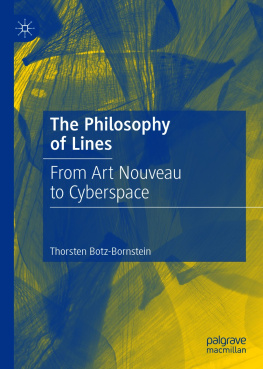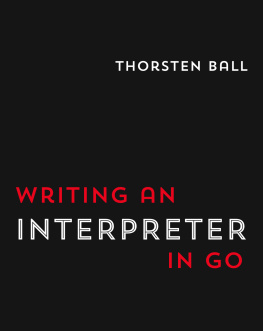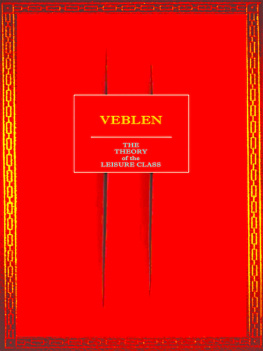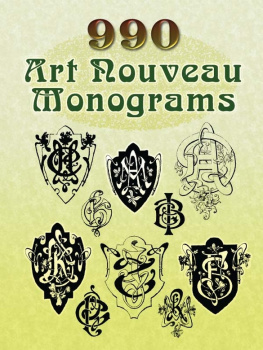Thorsten Botz-Bornstein - The Philosophy of Lines: From Art Nouveau to Cyberspace
Here you can read online Thorsten Botz-Bornstein - The Philosophy of Lines: From Art Nouveau to Cyberspace full text of the book (entire story) in english for free. Download pdf and epub, get meaning, cover and reviews about this ebook. year: 2021, publisher: Springer Nature, genre: Romance novel. Description of the work, (preface) as well as reviews are available. Best literature library LitArk.com created for fans of good reading and offers a wide selection of genres:
Romance novel
Science fiction
Adventure
Detective
Science
History
Home and family
Prose
Art
Politics
Computer
Non-fiction
Religion
Business
Children
Humor
Choose a favorite category and find really read worthwhile books. Enjoy immersion in the world of imagination, feel the emotions of the characters or learn something new for yourself, make an fascinating discovery.
- Book:The Philosophy of Lines: From Art Nouveau to Cyberspace
- Author:
- Publisher:Springer Nature
- Genre:
- Year:2021
- Rating:4 / 5
- Favourites:Add to favourites
- Your mark:
- 80
- 1
- 2
- 3
- 4
- 5
The Philosophy of Lines: From Art Nouveau to Cyberspace: summary, description and annotation
We offer to read an annotation, description, summary or preface (depends on what the author of the book "The Philosophy of Lines: From Art Nouveau to Cyberspace" wrote himself). If you haven't found the necessary information about the book — write in the comments, we will try to find it.
The Philosophy of Lines: From Art Nouveau to Cyberspace — read online for free the complete book (whole text) full work
Below is the text of the book, divided by pages. System saving the place of the last page read, allows you to conveniently read the book "The Philosophy of Lines: From Art Nouveau to Cyberspace" online for free, without having to search again every time where you left off. Put a bookmark, and you can go to the page where you finished reading at any time.
Font size:
Interval:
Bookmark:


Cover illustration: Marina Lohrbach_shutterstock.com
This Palgrave Macmillan imprint is published by the registered company Springer Nature Switzerland AG.
The registered company address is: Gewerbestrasse 11, 6330 Cham, Switzerland
Perhaps no one before Klee had let a line dream. The beginning of the lines path establishes or installs a certain level or mode of the linear, a certain manner for the line to be and to make itself a line.
Merleau-Ponty, Eye and Mind
This book gives a philosophical account of the line as a phenomenon found in culture. It describes lines in many areas but primarily attempts to crystallize a philosophy of lines that emerged in Europe around 1850 and developed over the twentieth century to this day. The development was supported by thinkers and artists such as Heinrich Wlfflin , Adolf Loos , Felix Ravaisson , Henri Bergson , Maurice Merleau-Ponty , Paul Klee , Wassily Kandinsky , Piet Mondrian , or Henri Michaux . At the turn of the nineteenth century, a new scientific environment, manifesting in the emergence of non-Euclidean geometry, influenced modern art. However, while the reality of non-Euclidean geometry is abstract, mathematical, and technical, artists of early modernity used lines to create an existential-aesthetic virtual reality . This new geometry would not lead to the lines technical virtualization but rather to its poetic virtualization.
I extract, from the works of the above aestheticians and artists, a peculiar philosophy of lines that I find compatible with the aesthetics of lines practiced in East Asian calligraphy and painting. In both the Western non-Euclidean tradition, and in Chinese and Japanese calligraphy , lines are used to represent realities not only through affirmation, but also through negation. On the one hand, this aesthetics negates the concrete spatial dimension of the line; on the other hand, it does not push the line towards purely geometrical or digital abstraction. The line remains linked to a surface, an environment, and a body. This paradoxical concept of the line also inaugurates a peculiar idea of the virtual that has become important at the end of the twentieth century. However, in some points, this virtuality is different from, and even clashes with, what is most commonly understood as virtuality today.
I show that several Western aestheticians and artists slowly pushed the line towards various stages of negativity. Heinrich Wlfflin perceived the depreciation of the line as a boundary, and Maurice Merleau-Ponty saw lines as dynamic phenomena. Ludwig Wittgenstein suggested that lines challenge the human intellect, not through their blurred character, but through a more sophisticated procedure of self-negation. For Kandinsky , the line existed as a negation of forces: the straight line is a negation of the plane. More radically, Piet Mondrian believed that in his paintings, lines destroy each other through an effect of mutual opposition. The French poet-painter Henri Michaux relied on a divestment (dsaisissement) of the line, that is, on the lines negative values. More recently, the British artists collective Tracey suggested that drawing is uncertain, defiantly idiosyncratic, marking specific difference rather than aspiring to universal values, stubbornly refusing resolved forms, and incorporating the principle of erasure the will to unmark (Tracey: xi). For all these thinkers and artists, the line is not simply present (abstractly or concretely), but its existence is linked to a complex ontology that employs both affirmation and negation. Such reflections go beyond the implied line or the guideline, which are known in art and architecture since Vitruvius and Leon Battista Alberti . The implied line is invisible whereas the negative line is drawn and most often visible. However, though physically visible, the negative line is not an object (not even a suggested or imagined one) but rather a Heideggerian Ding. It is an organism with existential dimensions, which becomes most obvious when we look at the lines link to the body. Again, this does not mean that the line is animistic or the personification of an ego. On the contrary, the line is emptied out: it is divested of all ego notions.
I compare these approaches to the way lines are handled in the East Asian tradition. Japanese and Chinese art, under the influence of Daoism and Zen Buddhism , have always had an understanding of the line that comes close to the one described above. One reason is that this tradition of lines has never been impacted by Plato or Euclid . Another reason is that it has traditionally operated with an alternative understanding of the virtual.
Much has been written about lines from anthropological, philosophical, or scientific points of view. In this book, I concentrate on the most peculiar characteristic of the line, which is its ambiguous ontological status. Lines can be physical phenomena, cognitive responses to observed processes, or both at the same time. My approach is always philosophical or aesthetic in the broadest sense. Archaeologists, anthropologists, linguists, or geographers will find interesting philosophical ideas in this book, but they will also recognize that my method is very different from theirs. My purpose is not merely to show that lines as human-made artifacts have had different meanings at different times or in different places. Instead, I concentrate on the negative line or the self-negating line and detect common patterns in East and West.
Font size:
Interval:
Bookmark:
Similar books «The Philosophy of Lines: From Art Nouveau to Cyberspace»
Look at similar books to The Philosophy of Lines: From Art Nouveau to Cyberspace. We have selected literature similar in name and meaning in the hope of providing readers with more options to find new, interesting, not yet read works.
Discussion, reviews of the book The Philosophy of Lines: From Art Nouveau to Cyberspace and just readers' own opinions. Leave your comments, write what you think about the work, its meaning or the main characters. Specify what exactly you liked and what you didn't like, and why you think so.










